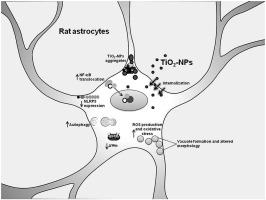当前位置:
X-MOL 学术
›
Chem. Biol. Interact.
›
论文详情
Our official English website, www.x-mol.net, welcomes your
feedback! (Note: you will need to create a separate account there.)
Titanium dioxide nanoparticles promote oxidative stress, autophagy and reduce NLRP3 in primary rat astrocytes.
Chemico-Biological Interactions ( IF 4.7 ) Pub Date : 2020-01-28 , DOI: 10.1016/j.cbi.2020.108966 José Antonio Pérez-Arizti 1 , José Luis Ventura-Gallegos 2 , Roberto Erasmo Galván Juárez 3 , María Del Pilar Ramos-Godinez 4 , Zaira Colín-Val 5 , Rebeca López-Marure 5
Chemico-Biological Interactions ( IF 4.7 ) Pub Date : 2020-01-28 , DOI: 10.1016/j.cbi.2020.108966 José Antonio Pérez-Arizti 1 , José Luis Ventura-Gallegos 2 , Roberto Erasmo Galván Juárez 3 , María Del Pilar Ramos-Godinez 4 , Zaira Colín-Val 5 , Rebeca López-Marure 5
Affiliation

|
Titanium dioxide nanoparticles (TiO2-NPs) are widely used in the food industry, cosmetics, personal care and paints among others. Through occupational exposure and daily consumption, and because of their small size, TiO2-NPs can enter the body through different routes such as oral, dermal and inhalation, and accumulate in multiple organs including the brain. TiO2-NPs cause severe damage to many cell types, however their effects in the central nervous system remain largely unexplored. Therefore, in the present study we determined the cytotoxic effect of TiO2-NPs on rat astrocytes. We tested the oxidant properties of TiO2-NPs through DTT depletion, and measured oxidative stress-induced damage in mitochondria, through oxidation of 2,7-dichlorodihydrofluorescein diacetate (H2DCFDA) and loss of mitochondrial membrane potential (ΔΨm) with Mitotracker Green FM. We further examined oxidative stress-derived responses such as IκB-α degradation by Western Blot, NF-κB translocation by EMSA, autophagy induction by LC3-II levels, and expression of the inflammasome protein NLRP3. TiO2-NPs showed high oxidant properties and induced strong oxidative stress in astrocytes following their internalization, causing mitochondrial damage detected by ΔΨm loss. Responses against oxidative damage such as NF-κB translocation and autophagy were induced and NLRP3 protein expression was downregulated, indicating lower inflammasome-mediated responses in astrocytes. These results support TiO2-NPs cytotoxicity in astrocytes, cells that play key roles in neuronal homeostasis and their dysfunction can lead to neurological disorders including cognitive impairment and memory loss.
中文翻译:

二氧化钛纳米颗粒促进原代大鼠星形胶质细胞的氧化应激,自噬并减少NLRP3。
二氧化钛纳米颗粒(TiO2-NPs)广泛用于食品工业,化妆品,个人护理和油漆等。通过职业接触和日常消费,由于其体积小,TiO2-NPs可以通过不同的途径进入体内,例如口服,皮肤和吸入,并在包括大脑在内的多个器官中积累。TiO2-NPs对许多细胞类型造成严重损害,但是它们在中枢神经系统中的作用仍未开发。因此,在本研究中,我们确定了TiO2-NPs对大鼠星形胶质细胞的细胞毒性作用。我们通过DTT耗尽测试了TiO2-NPs的氧化性能,并通过氧化2来测定线粒体中氧化应激诱导的损伤,用Mitotracker Green FM处理7-二氯二氢荧光素二乙酸盐(H2DCFDA)并降低线粒体膜电位(ΔΨm)。我们进一步检查了氧化应激衍生的应答,例如Western Blot对IκB-α的降解,EMSA对NF-κB的转运,LC3-II水平的自噬诱导以及炎性体蛋白NLRP3的表达。TiO2-NPs内在化后,在星形胶质细胞中显示出高的氧化特性并引起强烈的氧化应激,从而导致ΔΨm丢失而导致线粒体损伤。诱导了针对氧化损伤的响应,例如NF-κB易位和自噬,并且NLRP3蛋白表达下调,表明星形胶质细胞中炎性体介导的响应降低。这些结果支持了TiO2-NPs在星形胶质细胞中的细胞毒性,
更新日期:2020-01-30
中文翻译:

二氧化钛纳米颗粒促进原代大鼠星形胶质细胞的氧化应激,自噬并减少NLRP3。
二氧化钛纳米颗粒(TiO2-NPs)广泛用于食品工业,化妆品,个人护理和油漆等。通过职业接触和日常消费,由于其体积小,TiO2-NPs可以通过不同的途径进入体内,例如口服,皮肤和吸入,并在包括大脑在内的多个器官中积累。TiO2-NPs对许多细胞类型造成严重损害,但是它们在中枢神经系统中的作用仍未开发。因此,在本研究中,我们确定了TiO2-NPs对大鼠星形胶质细胞的细胞毒性作用。我们通过DTT耗尽测试了TiO2-NPs的氧化性能,并通过氧化2来测定线粒体中氧化应激诱导的损伤,用Mitotracker Green FM处理7-二氯二氢荧光素二乙酸盐(H2DCFDA)并降低线粒体膜电位(ΔΨm)。我们进一步检查了氧化应激衍生的应答,例如Western Blot对IκB-α的降解,EMSA对NF-κB的转运,LC3-II水平的自噬诱导以及炎性体蛋白NLRP3的表达。TiO2-NPs内在化后,在星形胶质细胞中显示出高的氧化特性并引起强烈的氧化应激,从而导致ΔΨm丢失而导致线粒体损伤。诱导了针对氧化损伤的响应,例如NF-κB易位和自噬,并且NLRP3蛋白表达下调,表明星形胶质细胞中炎性体介导的响应降低。这些结果支持了TiO2-NPs在星形胶质细胞中的细胞毒性,











































 京公网安备 11010802027423号
京公网安备 11010802027423号